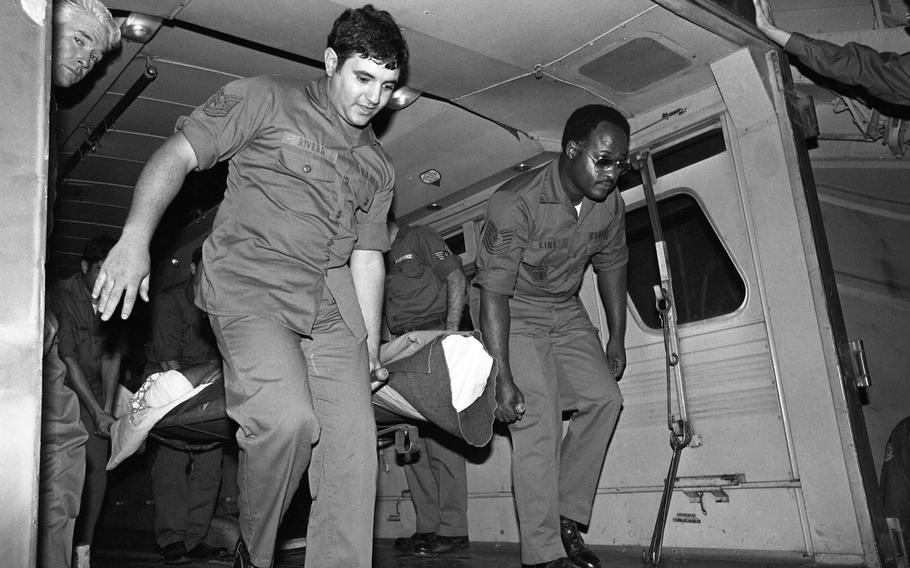
An unidentified burn victim is carried on a stretcher out of an ambulance onto a C-141 Air Force plane to be strapped in for the flight Oct. 22, 1979. (Ron Hatcher/Stars and Stripes)
This article first appeared in the Stars and Stripes Pacific edition, Oct. 21, 1979. It is republished unedited in its original form. It was the first report on the Camp Fuji fire in Stars and Stripes. In the end the Camp Fuji fire would claim 13 lives and injure 81. The accompanying photos were taken in the days after the initial fire.
CAMP FUJI, Japan — Typhoon Tip trigged a freak fire here Friday [Oct. 19, 1979] that killed a Marine and injured at least 41 other persons, according to Marine officials.
The dead man’s name is being withheld pending notification of his relatives.
At least seven Marines are listed in serious condition at Yokota AB, said a U.S. Forces Japan spokesman.
The dead man was to have returned to the United States Wednesday, according to one of his friends.
Lt. Col. John Redgate, commander of a battalion landing team at Camp Fuji, said about 5,000 gallons of gasoline burst free from a rubber storage bladder and ran through the camp before being ignited by a stove.
Redgate said the bladder was secured behind a retaining wall, but rains from the storm eroded the wall and allowed the bladder to slip. As it slipped, he said, hoses were torn free, spilling the gasoline.
The “fuel farm” is uphill from the Quonset huts where more than 1,300 Marines were huddled against the raging typhoon.
“I’ve been in this business 23 years and have never seen anything like this,” aid a Navy medical officer from Atsugi NAF.
Navy Hospitalman Fred Odom barely escaped the fire to assist in treating the injured. He said he was lying on his bunk writing a letter when he heard an explosion and saw the bunk across from him burst into flames. He said he jumped out of bed and saw flames spreading over the floor. “I looked back and my bunk was on fire,” he said. “I made it out the door by running across the tops of the bunks.”
Odom said many of the Marines had barricaded doors and even nailed some shut because of the typhoon’s wind. He said many of the men crawled out windows to escape.
“People were screaming all around me,” he said, “and when I got outside there were guys wrapped in blankets rolling in the mud.”
Hospitalman Timothy Terrell said fire was shooting out the windows of the huts “like torches.” He said he saw naked men outside, crying, their bodies smoking and skin falling off. “when we tried to get them inside the aid station,” he said,” “many refused to come in out of the rain. I guess the rain felt soothing to them.”
Terrell said one of the injured men pleaded with him, “Please, Doc, take care of me, take care of me. Don’t let me die.”
Redgate said 14 Quonset huts were destroyed and several damaged in the fire. He said the camp laundry was destroyed and the camp exchange and gift shop were damaged. Damage estimates were not available.
Redgate said 39 Marines were injured in the fire along with two Japanese employees. A United Press International report said three Japanese were injured in the fire.
One of them, Sumiko Yuasa, told UPI, “I would have been killed if a U.S. Marine did not rescue me.”
All of the injured were taken to hospitals in Gotemba, a city near the camp, for initial treatment. They were ferried overnight to Yokota AB aboard Navy, Army and Air Force helicopters.
Medical supplies and personnel were flown in to Yokota and Fuji from several U.S. bases in Japan said Redgate.
He said a burn treatment team was on its way from Brooke Army Medical Center in San Antonio, Tex. Redgate said the team would determine which patients would return with them for treatment in San Antonio. Brooke is the military’s major burn center.
Japanese firemen fought the blaze in the rain and 50mph winds for more than two hours, said Redgate, before it was brought under control. “It was under control,” he said, “but it wasn’t put out. It just had to burn itself out.”
The buildings were still smoldering at daybreak Saturday.
Tip, the strongest typhoon to hit Japan in 13 years, left 25 persons dead as it swept Japan. Among the dead was a Marine swept to sea when Tip brushed Okinawa. Typhoon Tip had winds gusting to 115 mph.
The rains destroyed at least 138 houses and flooded 20,000 others. In the metropolitan Tokyo area train service came to a virtual halt, affecting some 4 million commuters. Tokyo’s largest buildings swayed in the gusts.
Tip knocked out 550 roads throughout Japan and ruined 45 bridges. Five ships sank in heavy seas off the coast.
Read the 2018 article on the 39th anniversary commemoration of the Camp Fuji fire here.